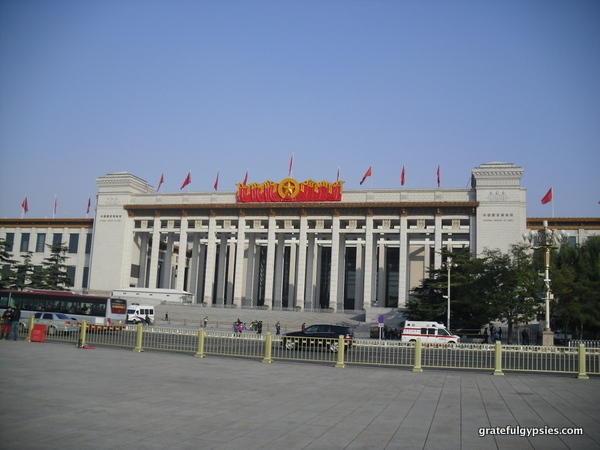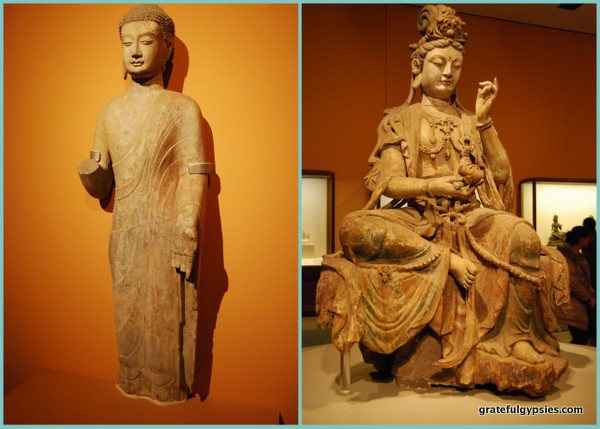A Guide to Tiananmen Square Posted by sasha on Oct 7, 2015 in Uncategorized
Tiananmen Square (天安门广场 – tiān’ān mén guǎng chǎng) is without a doubt one of the most famous places in all of China, although the reasons vary depending on who you ask. For almost all Chinese people, the first thing they associate Tiananmen with is the founding of the People’s Republic of China, which Mao Zedong announced from the square on October 1, 1949. On this day, the country celebrates its National Day. Tens of thousands of Chinese people from all corners of the country flock to Tiananmen to celebrate and show their patriotism. Those who are extra dedicated make it there at sunrise to view the daily flag raising ceremony.

A painting in the National Museum depicting 10/1/1949.
For most people outside of China, the first thing they associate with Tiananmen Square are the deadly protests that occurred there in 1989. A pro-democracy movement led by college students ended in a massacre as troops moved in on tanks and fired on the crowd. The death toll varies greatly depending on the source, between a few hundred and a few thousand. For many, the image they have of Tiananmen Square will forever be that of “tank man” – one brave man standing up to a row of tanks coming down Chang’an Avenue.
All mentions of the Tiananmen Square Massacre are completely blocked on the Chinese web, and this part of the country’s history has conveniently not been placed in textbooks. A good majority of Chinese people have absolutely zero idea that this ever happened. It’s no wonder then that for so many people, the square remains a point of pride and historical significance. Many Chinese dream of one day making it to Beijing to visit Tiananmen Square, just as many Americans hope to see the White House at some point in their life. This blog post is not meant to discuss the events of 1989 or the Chinese government’s censorship of them, but rather to take a closer look at Tiananmen Square and the various places in and around it to teach a bit of Chinese language and culture.
Where Does the Name Come From?

The Gate of Heavenly Peace
The square is named after the nearby Gate of Heavenly Peace (天安门 – tiān’ān mén), which is located to the north and separates the square from the Forbidden City. Adorning the large red gate is a portrait of Chairman Mao along with two messages:
“Long live the People’s Republic of China”
中华人民共和国万岁 (zhōng huá rén mín gòng hé guó wàn suì)
“Long live the great unity of the world’s peoples”
世界人民大团结万岁 (shì jiè rén mín dà tuán jié wàn suì)
History

The 4th largest square in the world.
Tiananmen Square was designed and built back in 1651. Originally meant to function simply as a place for the emperor to be carried across, the square would undergo many renovations and enlargements through the years. Mao had a vision to make it the largest square in the world – one that could hold up to 500,000 people and host massive rallies. The Gate of China (中华门 – zhōng huá mén) and many residential buildings were torn down in 1958, allowing the square to expand to four times its original size. To celebrate the 10th anniversary of the PRC, a few new structures were built – the Monument to the People’s Heroes inside of the square and the Great Hall of the People and National Museum on the west and east sides, respectively. After Mao’s death in 1976, a mausoleum was built on the southern end of the square to hold his preserved body. At this time the square was enlarged yet again, and it can now hold up to 600,000 people. Currently, it’s the 4th-largest square in the world.
Important Landmarks

Monument to the People’s Heroes
The Monument to the People’s Heroes (人民英雄纪念碑 – rén mín yīng xióng jì niàn bēi) was erected as a monument to the martyrs of revolutionary struggle that occurred in China in the 19th and 20th centuries. It is 38 meters (125 feet) tall and made of marble and granite. The front of the monument features an inscription in Chairman Mao’s handwriting that reads “Eternal glory to the people’s heroes” (人民英雄永垂不朽 – rén mín yīng xióng yǒng chuí bù xiǔ). There are also reliefs that depict eight important revolutionary episodes in the country’s history, such as the May 4th Movement and the War of Resistance Against Japan. The monument was used extensively as a rallying point in the protests of ’89, which has led to strict regulations and security.

Great Hall of the People
The Great Hall of the People (人民大会堂 – rén mín dà huì táng) is located to the west of the square and is used for legislative and ceremonial purposes. Every March, the National People’s Congress meets here. Every five years, the National Congress of the Communist Party of China also holds meetings here. Built in 1959 as one of “Ten Great Buildings” (十大建筑shí dà jiàn zhú) to honor the 10th anniversary of the PRC, volunteers finished the huge building in just ten months. Apparently you can go in and take a look for 30 RMB, but I’ve never tried.

Inside the National Museum.
The National Museum (国家博物馆 – guó jiā bó wù guǎn) was also built in 1959, but it has undergone quite a few changes since then. Originally two separate museums – Chinese Revolution and Chinese History – they were merged in 2003 and brought together under one name. It was closed for four years for massive renovations and reopened in 2011. The museum now focuses primarily on Chinese art and history, featuring an extensive collection of artifacts and great descriptions in both Chinese and English. Free for all visitors, the museum is probably the most useful and interesting thing you can do in the vicinity of Tiananmen.

Buddhist artifacts in the museum.

Mausoleum of Mao Zedong
If looking at preserved cadavers of dictators is your thing, check out the Mausoleum of Mao Zedong (毛主席纪念堂 – máo zhǔ xí jì niàn táng). Despite the fact that the Chairman asked to be cremated, his body was embalmed and this grand mausoleum was constructed. It’s open only in the mornings from Tuesday-Sunday, with an extra afternoon session added on the anniversary of his death (September 9) and his birthday (December 26). Thousands of people line up to pay their respects to the Great Helsman by purchasing plastic flowers and laying them in front of him, which are later swept up and resold the next day. Fitting considering that many believe the body currently on display to actually be made of wax, as it’s rumored that there was a bit of a mishap in the original embalming process. I’ve never felt the urge to go inside, so I can only speak from what others have told me.

Zhengyangmen
Continuing south from Mao’s mausoleum, you’ll find Zhengyangmen (正阳门 – zhèng yáng mén), the “Gate of the Zenith Sun.” Once a gate in Beijing’s city wall, it now serves as another tourist attraction. Visitors can buy a ticket and go up on the gate for good views of the square, or put on imperial clothing and pose for silly pictures. Although most of the original city wall was destroyed, this gate remains an important landmark as it lies on the city’s north-south axis.

How could we pass up this photo opp?
There you have it, folks – a rough guide to Tiananmen Square. Hopefully now you understand a bit more of why this place remains very important to the people of China. It is unfortunate that it was also home to the worst event in modern Chinese history, but there’s still a lot of cultural and historical significance to the square. Should you visit Beijing, definitely dedicate at least half a day to exploring the square and its surroundings.

Build vocabulary, practice pronunciation, and more with Transparent Language Online. Available anytime, anywhere, on any device.
About the Author: sasha
Sasha is an English teacher, writer, photographer, and videographer from the great state of Michigan. Upon graduating from Michigan State University, he moved to China and spent 5+ years living, working, studying, and traveling there. He also studied Indonesian Language & Culture in Bali for a year. He and his wife run the travel blog Grateful Gypsies, and they're currently trying the digital nomad lifestyle across Latin America.




Leave a comment: